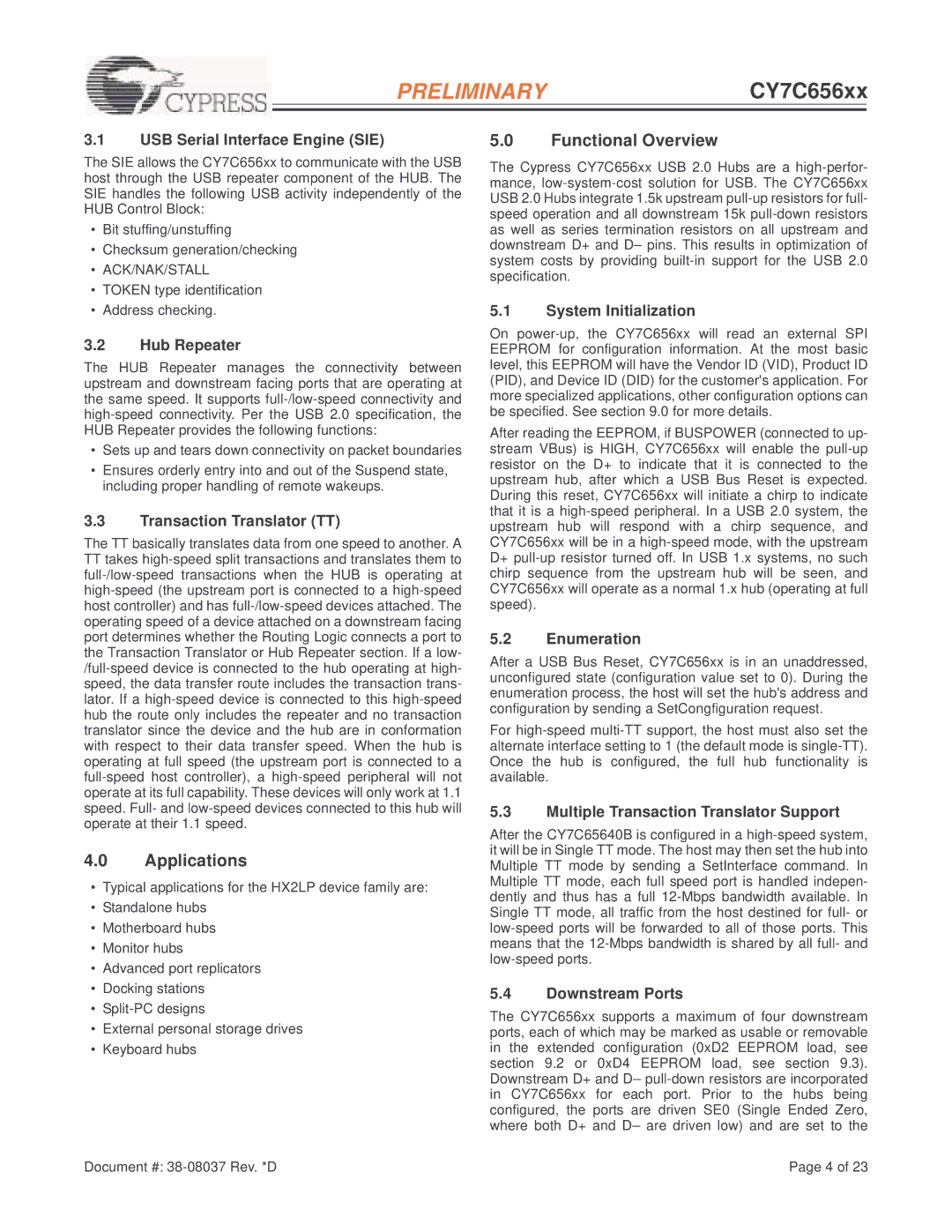3.1USB Serial Interface Engine (SIE)
The SIE allows the CY7C656xx to communicate with the USB host through the USB repeater component of the HUB. The SIE handles the following USB activity independently of the HUB Control Block:
•Bit stuffing/unstuffing
•Checksum generation/checking
•ACK/NAK/STALL
•TOKEN type identification
•Address checking.
3.2Hub Repeater
The HUB Repeater manages the connectivity between upstream and downstream facing ports that are operating at the same speed. It supports full-/low-speed connectivity and high-speed connectivity. Per the USB 2.0 specification, the HUB Repeater provides the following functions:
•Sets up and tears down connectivity on packet boundaries
•Ensures orderly entry into and out of the Suspend state, including proper handling of remote wakeups.
3.3Transaction Translator (TT)
The TT basically translates data from one speed to another. A
TTtakes high-speed split transactions and translates them to full-/low-speed transactions when the HUB is operating at high-speed (the upstream port is connected to a high-speed host controller) and has full-/low-speed devices attached. The operating speed of a device attached on a downstream facing port determines whether the Routing Logic connects a port to the Transaction Translator or Hub Repeater section. If a low- /full-speed device is connected to the hub operating at high- speed, the data transfer route includes the transaction trans- lator. If a high-speed device is connected to this high-speed hub the route only includes the repeater and no transaction translator since the device and the hub are in conformation with respect to their data transfer speed. When the hub is operating at full speed (the upstream port is connected to a full-speed host controller), a high-speed peripheral will not operate at its full capability. These devices will only work at 1.1 speed. Full- and low-speed devices connected to this hub will operate at their 1.1 speed.
4.0Applications
•Typical applications for the HX2LP device family are:
•Standalone hubs
•Motherboard hubs
•Monitor hubs
•Advanced port replicators
•Docking stations
•Split-PC designs
•External personal storage drives
•Keyboard hubs
5.0Functional Overview
The Cypress CY7C656xx USB 2.0 Hubs are a high-perfor- mance, low-system-cost solution for USB. The CY7C656xx USB 2.0 Hubs integrate 1.5k upstream pull-up resistors for full- speed operation and all downstream 15k pull-down resistors as well as series termination resistors on all upstream and downstream D+ and D– pins. This results in optimization of system costs by providing built-in support for the USB 2.0 specification.
5.1System Initialization
On power-up, the CY7C656xx will read an external SPI EEPROM for configuration information. At the most basic level, this EEPROM will have the Vendor ID (VID), Product ID (PID), and Device ID (DID) for the customer's application. For more specialized applications, other configuration options can be specified. See section 9.0 for more details.
After reading the EEPROM, if BUSPOWER (connected to up- stream VBus) is HIGH, CY7C656xx will enable the pull-up resistor on the D+ to indicate that it is connected to the upstream hub, after which a USB Bus Reset is expected. During this reset, CY7C656xx will initiate a chirp to indicate that it is a high-speed peripheral. In a USB 2.0 system, the upstream hub will respond with a chirp sequence, and CY7C656xx will be in a high-speed mode, with the upstream D+ pull-up resistor turned off. In USB 1.x systems, no such chirp sequence from the upstream hub will be seen, and CY7C656xx will operate as a normal 1.x hub (operating at full speed).
5.2Enumeration
After a USB Bus Reset, CY7C656xx is in an unaddressed, unconfigured state (configuration value set to 0). During the enumeration process, the host will set the hub's address and configuration by sending a SetCongfiguration request.
For high-speed multi-TT support, the host must also set the alternate interface setting to 1 (the default mode is single-TT). Once the hub is configured, the full hub functionality is available.
5.3Multiple Transaction Translator Support
After the CY7C65640B is configured in a high-speed system, it will be in Single TT mode. The host may then set the hub into Multiple TT mode by sending a SetInterface command. In Multiple TT mode, each full speed port is handled indepen- dently and thus has a full 12-Mbps bandwidth available. In Single TT mode, all traffic from the host destined for full- or low-speed ports will be forwarded to all of those ports. This means that the 12-Mbps bandwidth is shared by all full- and low-speed ports.
5.4Downstream Ports
The CY7C656xx supports a maximum of four downstream ports, each of which may be marked as usable or removable in the extended configuration (0xD2 EEPROM load, see section 9.2 or 0xD4 EEPROM load, see section 9.3). Downstream D+ and D– pull-down resistors are incorporated in CY7C656xx for each port. Prior to the hubs being configured, the ports are driven SE0 (Single Ended Zero, where both D+ and D– are driven low) and are set to the

